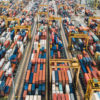With an extremely turbulent start to the new decade, logistics and transportation companies who are involved in the movement, storage and flow of goods have been directly impacted by the COVID-19 pandemic. Due to the nature of many logistics companies offering complex multilocational solutions across the globe, we’ve seen this sector having to rapidly adapt to meet radical changes in consumer behaviour.
That being said, now is an exciting time for transport and logistics. Companies that operate in the industry will need to adapt to a number of challenges and trends that are coming their way in 2021 and beyond, spurred on by wider developments such as the impact of COVID, Brexit, growing artificial intelligence and the rapid expansion of ecommerce.
During the course of this article, we’ll take a look at the main issues and changes faced by the sector in 2020 and predictions for 2021. Beginning with the global impact of COVID-19, the rise in e-commerce, labour shortage in transport and logistics, we’ll move on to address the productivity gap and important developments in governance and regulations.
The Impact of COVID-19 on the Logistics Sector
The global pandemic has been an incredibly challenging time for the logistic sector and arguably the world’s first circumstance of the supply chain being impacted on mass. Global manufacturing in China was first to feel the impact, being the epicenter of the pandemic and being a major consumer of products, whilst having a knock on effect after travel restrictions were implemented worldwide.

In the UK, land transport has been key to keep the country going throughout the nationwide lockdown. This as a result has meant that there’s been an overwhelming ecommerce boom to help consumers utilise contact-free delivery options and utmost convenience. The British Retail Consortium (BRC) reported that 61.9% of all non-food retail sales that took place in May 2020 were online, an increase of 31.4% from 2019.
Many logistics and transportation companies have implemented a range of new services to pivot and adapt their offerings to meet the needs of their customers, including; safety protocols and alternative modes of transport.
E-Commerce Boom
The growth of ecommerce in recent years has increased the pressure on the already strained supply of labour in the transport and logistics industry. What’s more, this trend shows no signs of slowing: current statistics suggest that ecommerce sales in the UK will have risen to US$84,885m in 2020 and by 2040, 95% of purchases worldwide will be made online.

With the unprecedented rise of online sales during the pandemic, it’s forecasted that despite moving out of lockdowns consumer behaviour is likely to favour online shopping as we move into “the new normal”. With many elderly consumers becoming accustomed to online shopping and with the growing worry of COVID-19 exposure, this untapped consumer group is predicted to shop online at least once a week.
Since March 2020, employees around the world have also started to adapt to work from home, to help stop the spread of the virus, which led many companies having to digitise almost overnight. With the rise of mass remote working and many saving on travel expenses, this is leading to many purchasing online, particularly supporting smaller businesses impacted by the pandemic.
Labour Shortage
As online sales increase and interests shift towards personalised service offerings and product variety, there are more and more job opportunities for workers throughout the supply chain, from warehouse operatives to HGV drivers. Yet one of the main challenges facing the industry is how to fill these new roles. There is a serious shortage of labour in transport and logistics, particularly in the UK where Brexit has begun to discourage EU workers.
New immigration rules which would look to implement a points-based immigration system and salary caps to limit the number of what it identifies as “low-skilled workers” coming to the UK would only exacerbate existing shortages in HGV drivers. Currently, around 13% of freight drivers are recruited from the EU, and the Freight Transport Association (FTA) suspects that the shortfall of drivers currently sits at around 59,000.
Major players in the industry have already begun to publicly acknowledge this problem, with DHL labelling it a ‘talent crisis’. There are too few workers in transport and logistics at almost every level, with the demand for both supply chain managers and lower-level workers outstripping the supply. DHL has warned that “even though more people are earning supply chain management degrees and certifications each year, it hasn’t been enough to fill current needs.”
The Technology Revolution
The sheer development of various technologies have been shown to be utilised within the transportation and logistic sector to increase efficiency, project more accurately and provide real-time insights across the supply chain.
The Internet of Things (IoT) for example, has contributed to the logistic industry to plan, monitor and increase security of their daily operations. An example of this would be end-to-end product tracking so consumers are able to accurately track the delivery process, from the warehouse to their doorstep, and for managers to monitor deliveries, reducing theft.
In addition to IoT, the rise of artificial intelligence (AI) has been continuously learning within the logistic environment, including sensors and online behaviour to reveal patterns and trends. This has helped companies, such as DHL, utilising their huge volume of supply chain data to make accurate data-led decisions with the aim to lower their overall margins whilst optimising their overall service output.
The Productivity Gap
Whilst the lack of workers is a major industry issue, productivity is another challenge facing managers who are in charge of existing employees. Our recent research into sick leave has shown that transport workers take off almost three times more days due to illness than the UK average: the mean number of sick days per year in the UK is just 4.4, whereas transport workers take 11.4 days on average.

Individual logistics companies can help to reduce the number of employee sick days and restore productivity levels by introducing time and attendance software to the workplace. By monitoring attendance more closely through an automated system, managers can easily identify where there are punctuality problems or recurrent patterns of absence that need to be addressed.
The spike in absence due to illness could be also combated by innovations in digital fitness technology (the use of digital data and analytics to improve efficiencies and productivity). For example, our time and attendance software package can be supported by biometric fingerprint or radio-frequency identification (RFID) and mobile access enhancing the accuracy and reliability of the system.
Sustainability Shift
With organisations globally are responding to the rise in consumer demand for greener products and more sustainable practices to minimise the negative economic, social or environmental impacts of sourcing goods and services.
As a result, it’s noticed that the world’s supply chain is broadly growing to become a lot more circular than linear. For example, national governments are urged to take actionable steps to cut down the waste from their supply chains in order to boost recycling and allow consumers to recover, repair or resell goods purchased.
Governance and Regulations
There are also significant regulatory changes on the horizon for the sector. Showing a continued commitment to environmental sustainability, local authorities in the UK are considering the implementation of Low Emission Zones (LEZs) and Clean Air Zones (CAZs). This development follows the introduction of the world’s first Ultra Low Emission Zone (ULEZ) in central London last April.
The potential introduction of LEZs in areas across the UK including Birmingham, Leeds, and Nottingham could affect transport and logistics in a number of ways:
- Some companies could choose to divert around the new LEZs at the expense of increased fuel prices and wages.
- Many firms could upgrade their vehicles in order to comply with new emission standards in the affected areas.
- Abatement technology could be fitted to freight vehicles in an effort to purify emissions (this form of technology may increase in popularity if new LEZs are created.
In addition to environmental regulation, international transport to and from the UK is likely to be affected by the impact of Britain’s exit from the EU at the end of 2020. That said, we can only speculate as to the extent of the interference this will cause. Some of the potential changes could have a huge impact on the industry. It is possible, for example, that VAT will be applied to aviation, shipping, and rail transactions from the UK to mainland Europe.
Brexit may also impact transport between the UK and non-EU countries. Air traffic rights between the UK and the US will need to be renegotiated. Currently, the UK is part of the EU-US Open Skies Agreement which allows for travel between points in the EU and the US – the UK will need to sign up to this and form similar bilateral agreements with other non-EU countries if the transport sector is to thrive moving forward.
Finally, we can expect to see changes in governance for logistics. Contrary to previous estimations, analysis of the evidence from the past decade shows that effective governance practices are closely correlated with increased organisational performance for logistics companies. This in itself may encourage companies to examine their current practices more closely and look for ways to improve.
In light of this, firms may begin to pay more attention to academic investigations into logistics governance. For example, recent research shows that third-party logistics (3PL) firms have seen operational performance improvements by emphasising process coordination and information sharing. This level of performance analysis can be achieved through the implementation of workforce management software and solutions which give an overview of performance and can help connect and streamline data sources. If other logistics companies respond to the findings of this research, they may make changes to increase transparency and trust, including the introduction of more detailed contracts for employees.
Hopefully this article has provided you with some insight into the challenges and trends the transport and logistics industry has faced in 2020 and what we’re predicted to face as we move into 2021. If you need help with increasing your organisation’s productivity levels, get in touch to discuss how our time and attendance software and payroll system can help you.




